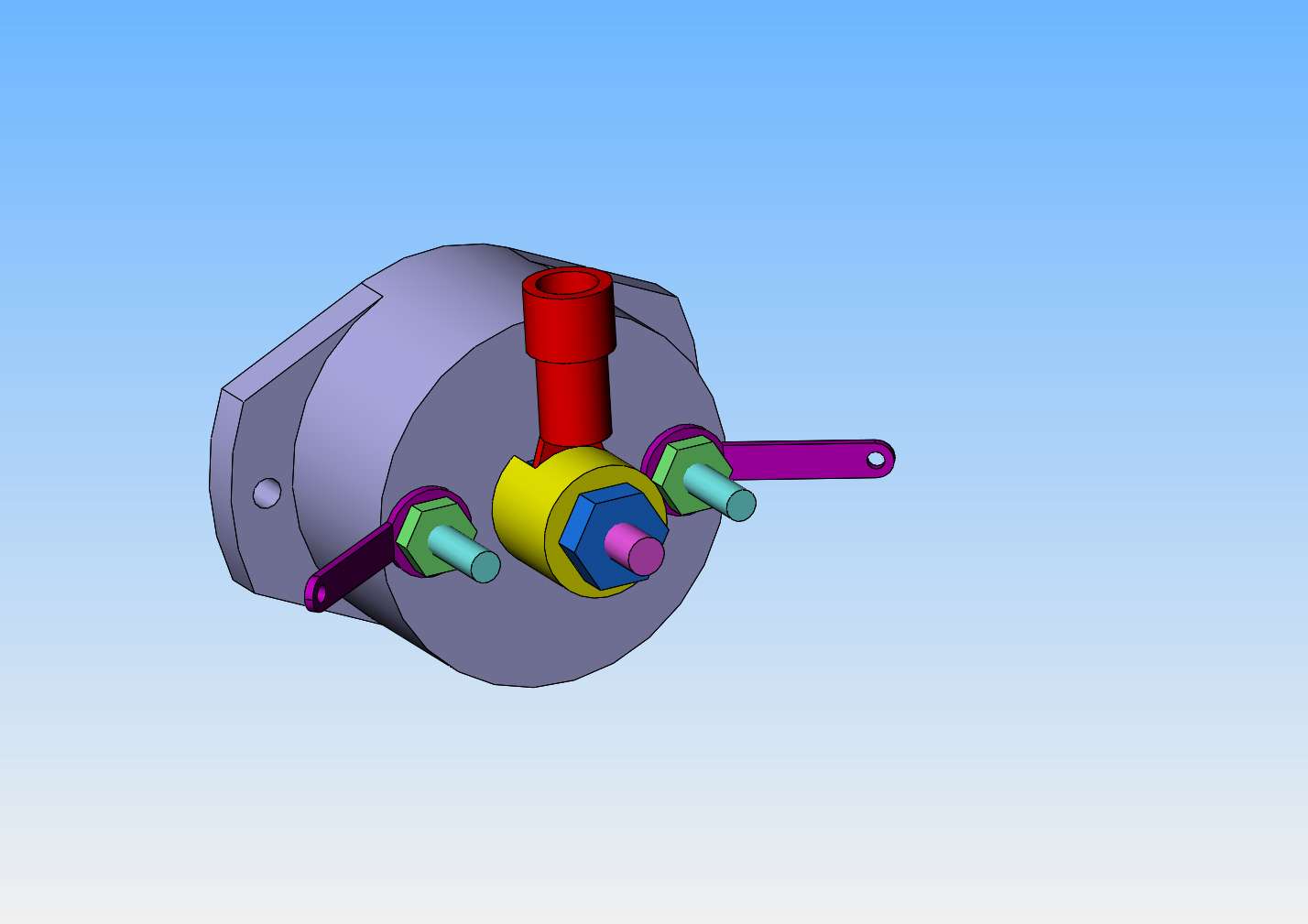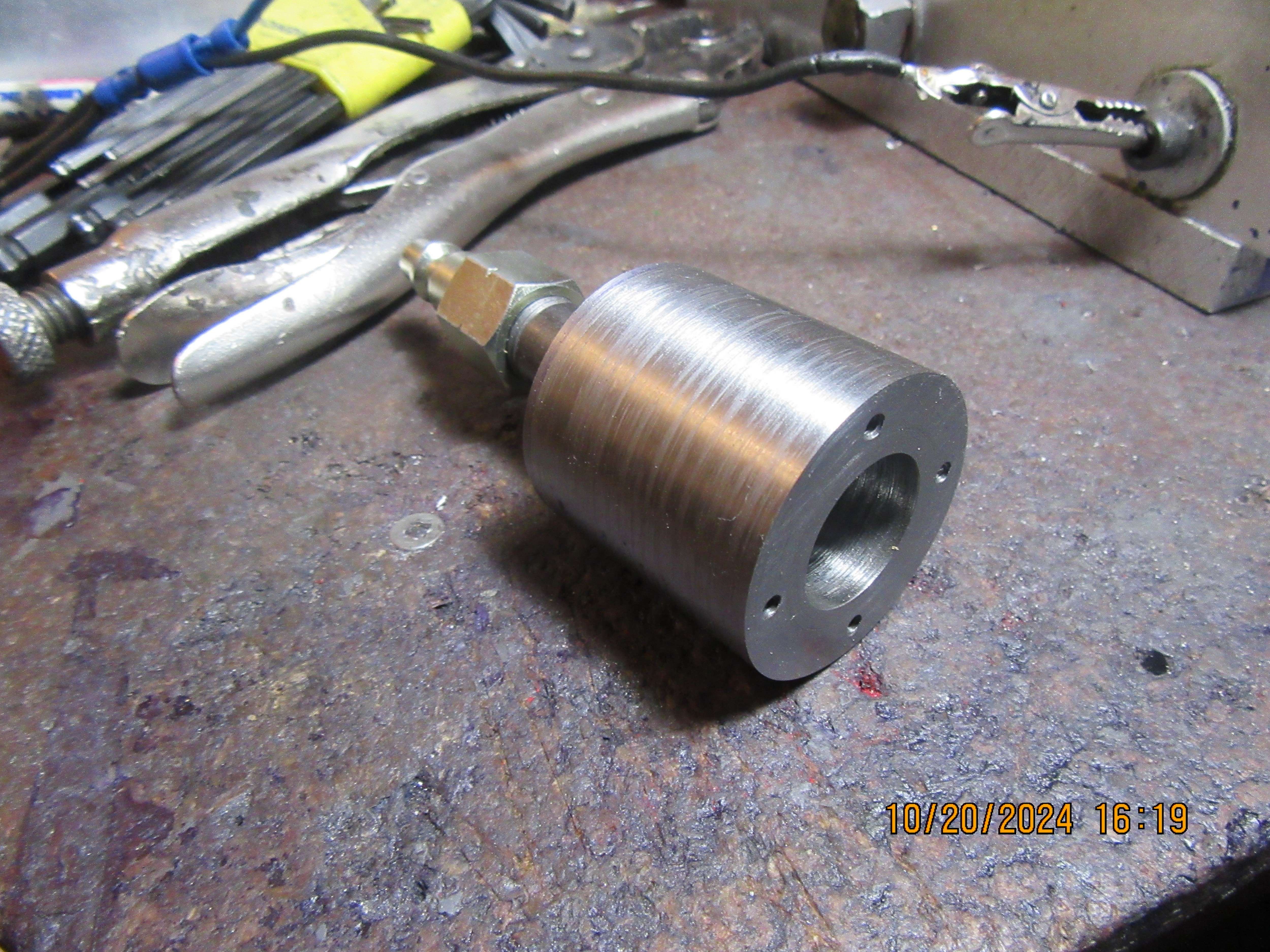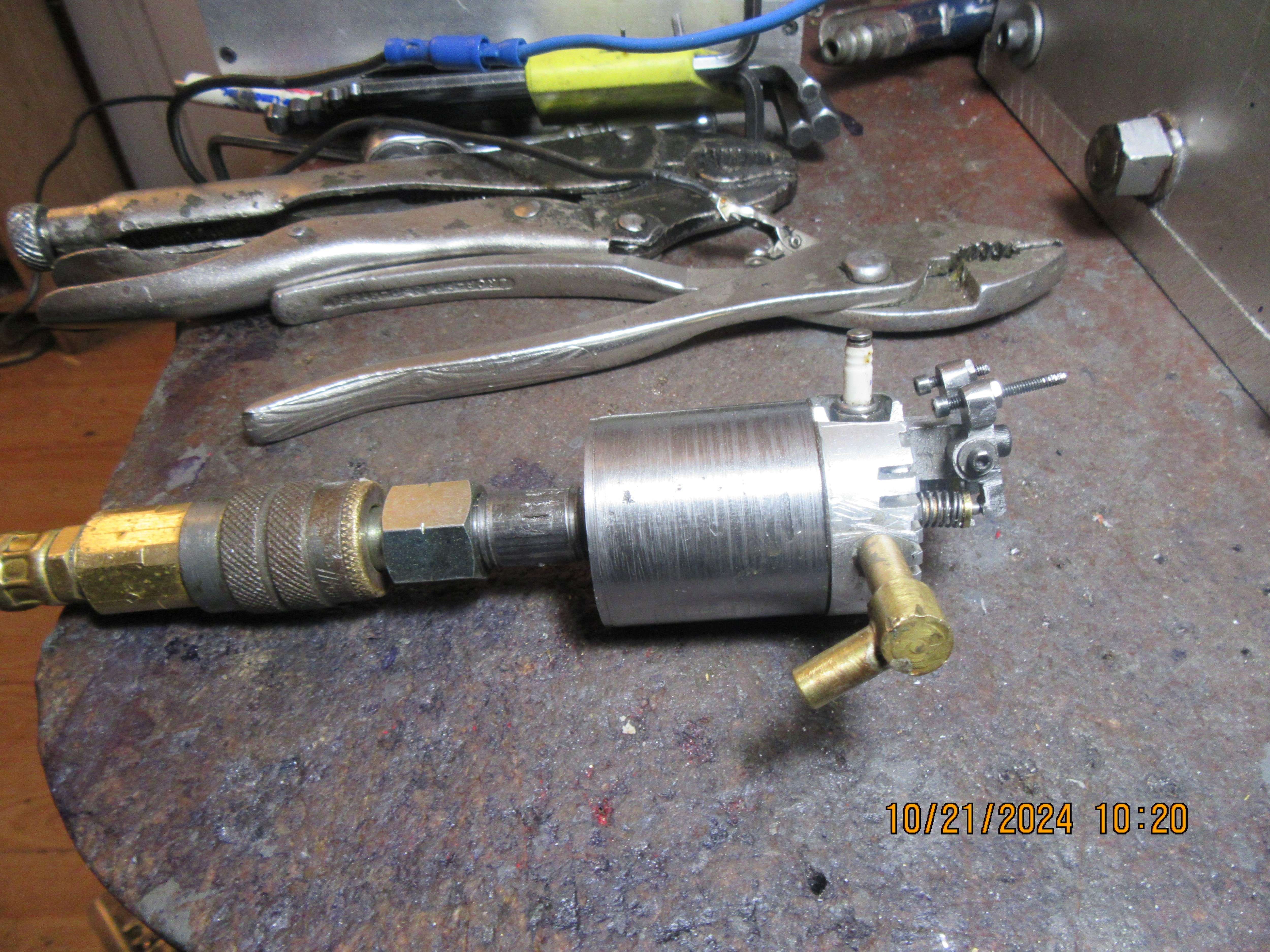A couple of twists of wire would do the job and look less cumbersome or bend your own from spring wire.
You are using an out of date browser. It may not display this or other websites correctly.
You should upgrade or use an alternative browser.
You should upgrade or use an alternative browser.
Upshur's opposed twin engine
- Thread starter Brian Rupnow
- Start date

Help Support Home Model Engine Machinist Forum:
This site may earn a commission from merchant affiliate
links, including eBay, Amazon, and others.
I thought I recalled Brian saying there was a hobby shop nearby. They should have tiny hose clamps, they use them a lot for Radio control stuff.A couple of twists of wire would do the job and look less cumbersome or bend your own from spring wire.
Amazon has about 5 lifetime supply for $10 of the flat spring clamps typical of fuel linesI don't like gear clamps!! On something big like a car radiator hose they are fine. On something as small as a model engine, not so much. I had hoped to get a smaller version of the spring clamp laying in the foreground, but couldn't find any in Barrie. I have just put the smallest gear clamps I could buy in town on the intake manifold tubes. Kind of ugly, but they will do for now.
https://www.amazon.ca/uxcell-Spring...lpcontext&ref_=fplfs&smid=A30WUG2ZDGM0XM&th=1
There's also these, only one lifetime supply for $10 but they look more like what you want
https://www.amazon.ca/uxcell-Double-Stainless-8-8mm-9-5mm-Silicone/dp/B0BDRZQ1Y3?th=1
Sparky, I already told him to try an RC shop as that is where I have got them.
Hundreads to choose from on Ali
https://fr.aliexpress.com/item/1005006252281364.html?spm=a2g0o.productlist.main.3.6e0d53dbHwW2AE&algo_pvid=33d35d06-8374-49e7-9822-ec83a12f2e4e&algo_exp_id=33d35d06-8374-49e7-9822-ec83a12f2e4e-1&pdp_npi=4@dis!GBP!0.83!0.83!!!7.50!7.50!@210385a817292801110432639e4e9d!12000036489253351!sea!UK!855056161!X&curPageLogUid=V9mg9NfcXNmf&utparam-url=scene:search|query_from:
https://fr.aliexpress.com/item/1005...ene:pcDetailBottomMoreOtherSeller|query_from:
Hundreads to choose from on Ali
https://fr.aliexpress.com/item/1005006252281364.html?spm=a2g0o.productlist.main.3.6e0d53dbHwW2AE&algo_pvid=33d35d06-8374-49e7-9822-ec83a12f2e4e&algo_exp_id=33d35d06-8374-49e7-9822-ec83a12f2e4e-1&pdp_npi=4@dis!GBP!0.83!0.83!!!7.50!7.50!@210385a817292801110432639e4e9d!12000036489253351!sea!UK!855056161!X&curPageLogUid=V9mg9NfcXNmf&utparam-url=scene:search|query_from:
https://fr.aliexpress.com/item/1005...ene:pcDetailBottomMoreOtherSeller|query_from:
I've been to the hobby shop in Barrie. They do not carry what I want in sizes large enough to go over a 3/8" o.d. gas line. The second ones that L98fiero suggests are probably as close as I am going to get to what I want.--Now that I have the gear clamps I will probably keep them, but I will definitely try the ones L98fiero suggests for the next engine I build. I tried to start the engine today, but there were sparks arcing across from my distributor center terminal to the outer terminals. I will build a new insulator (The yellow piece) and install it to try and prevent arcing.



$39.99
$49.99
Sunnytech Low Temperature Stirling Engine Motor Steam Heat Education Model Toy Kit For mechanical skills (LT001)
stirlingtechonline

$99.99
$109.99
AmTech300 - Boiler Treatment Professional Strength (Rust Inhibitor For Outdoor Wood Boilers)
Alternative Heating & Supplies

$426.53
DM14 Engine Build Kit, Metal Engine Build Model Great Metal Material for Engineer for Factory
Easoger Official

$649.00
$699.00
FoxAlien Masuter Pro CNC Router Machine, Upgraded 3-Axis Engraving All-Metal Milling Machine for Wood Acrylic MDF Nylon Carving Cutting
FoxAlien Official

$160.28 ($1.43 / oz)
Replacement Combustion Chamber Kit, Burnham V8 and V8H, 1-6 Sec, 108136-01, 1129
Plumbing Planet

$45.99
Sunnytech Mini Hot Air Stirling Engine Motor Model Educational Toy Kits Electricity HA001
stirlingtechonline

$40.02
$49.99
Becker CAD 12 3D - professional CAD software for 2D + 3D design and modelling - for 3 PCs - 100% compatible with AutoCAD
momox Shop

$188.98
TM NEXDYNAMI RE41157 Water Pump Compatible With/Replacement For/John Deere 6200 7400 6300 6600 6500 6400 7220 7600 7200 RE41157
VIVID MARKET CORPORATION
Yes--intake runners, not fuel line.
Today I pulled off both cylinder heads and blew an amazing amount of crap out of the holes which lead to the ends of the sparkplugs. I checked my spark timing with both heads off, and of course I was way off where it should be, so I reset the timing to give sparks at top dead center of the piston strokes. I didn't really like that spring device I had bolted in place to hold the throttle lever from moving, so I took Jason's advice and made up a very thin brass washer to fit between the carburetor body and the rubber o ring which holds everything in place. From what I see right now, my carburetor doesn't seem to be sucking up gas from the tank when the engine is being turned over by my starting table. I'm running Viton o-rings on my pistons and both cylinders have good compression. I'll have a closer look at my cam timing tomorrow.
This morning I went to a grandson's hockey game. My god, I can't believe the energy expended by two teams of 13 and 14 year old players. I don't think I ever had that energy level. When I got home---I made up this valve tester for my engine. The cylinder head with gasket bolts to one side, the air hose connects to the quick connect at the other end. I dial in the pressure I want to test the valves for at around 60 psi. Then I can open and shut the valves using the rocker arms. I've lost faith in my "blow your guts out" testing method. Seems like your guts can only generate 4 or 5 psi on a good day.


You said that you had good compression so why the need for a valve tester now? "I'm running Viton o-rings on my pistons and both cylinders have good compression"
Or was that just the pistons when the end of the head was covered by hand.
As I mentioned somewhere earlier in the thread all the muck that can be seen in the photos will quite likely get stuck on a valve seat and stop it sealing properly or chew up rings. Don't just blow the head clean but get the whole engine cleaned up, burr free etc.
Or was that just the pistons when the end of the head was covered by hand.
As I mentioned somewhere earlier in the thread all the muck that can be seen in the photos will quite likely get stuck on a valve seat and stop it sealing properly or chew up rings. Don't just blow the head clean but get the whole engine cleaned up, burr free etc.
Pressure test on cylinder one at 60 psi shows that neither valve is leaking---but big time leak around sparkplug . Quick and nasty cure for that is to use Loctite 638 on sparkplug threads, reinstall the sparkplug and torque it down. With aluminum heads, it is very touchy feely how tight you can torque down the sparkplug. It doesn't take much to pull the threads out of the aluminum head, and then you're pooched.


Jason--That "good compression" was with the cylinder heads off and my thumb held over the top of the cylinder as I rotated the crankshaft. As far as dirt is concerned--I clean up as I go along. Sometimes it's hard to tell. The engine is cleaned up now.
- Joined
- Dec 31, 2010
- Messages
- 812
- Reaction score
- 215
Don't you have the usual copper washer/gasket/ring on your spark plugs?
In this case, I am using an old set of sparkplugs that the copper rings have gone missing from.
- Joined
- Dec 31, 2010
- Messages
- 812
- Reaction score
- 215
Well. There ya go. And loctite is the answer?? (NOT)
The plugs don't really need to be tight. Use an O-ring under them to get you going until you can make some copper washers. Just a bit over finger tight is all you need with an O-ring.
The plugs don't really need to be tight. Use an O-ring under them to get you going until you can make some copper washers. Just a bit over finger tight is all you need with an O-ring.
You cold easily make some suitable gaskets from brass (I know you probably don't have copper) turning the ID and OD in the lathe then soften them by heating and quenching.Well. There ya go. And loctite is the answer?? (NOT)
The plugs don't really need to be tight. Use an O-ring under them to get you going until you can make some copper washers. Just a bit over finger tight is all you need with an O-ring.
Loctite is not the answer. (or JB weld for that matter!)
- Joined
- Jan 4, 2011
- Messages
- 1,430
- Reaction score
- 400
I have made them from some brass tube and just parted them off in the lathe. I made several because I know that I will drop some.You cold easily make some suitable gaskets from brass (I know you probably don't have copper) turning the ID and OD in the lathe then soften them by heating and quenching.
Loctite is not the answer. (or JB weld for that matter!)
Loctite works fine in this application. How do I know?---Because I've used it in this application before. 638 Loctite never grabs so bad that you can't unscrew the sparkplug.
And as the sun goes down---both cylinder heads have been pressure tested. The first cylinder head had no leaks around the valves at all. The second cylinder had very little leakage around the valves. Very small leaks will seal themselves after the engine has been ran for a while..
Similar threads
- Replies
- 413
- Views
- 59K
- Replies
- 25
- Views
- 6K
- Replies
- 27
- Views
- 4K
- Replies
- 61
- Views
- 12K
































![MeshMagic 3D Free 3D Modeling Software [Download]](https://m.media-amazon.com/images/I/B1U+p8ewjGS._SL500_.png)
























